Update! As a result of this review, Eartheasy, the North American distributor of the Lifestraw, sent me a few products to try out, and I appreciate when a company is willing to stand behind its products like that. I still feel that the Lifestraw itself is less useful than its fans make it out to be, and that the bottled version is the only version hikers and travelers should consider purchasing. I’ve given specific comments on the bottled version down below, which is worth a look as a portable filter for hiking and other outdoor activities.
As many of you may know, clean drinking water is kind of a big deal. The fact that nowadays we can get drinkable water, right at home, practically for free, is a downright revolutionary (and thoroughly recent) development, and one which remains entirely out of reach for billions throughout the world.
Enter the Lifestraw: A small, lightweight, portable, durable, relatively inexpensive filtration device that can hang around your neck like a necklace, providing you with filtered water wherever you go. It has won an endless string of accolades, and has even been called “one of the ten things that will change the way we live,” with legions of adoring fans singing its praises, swearing by its use in situations of all sorts.
Unfortunately, I think it’s bizarrely overrated.
What’s the Lifestraw?
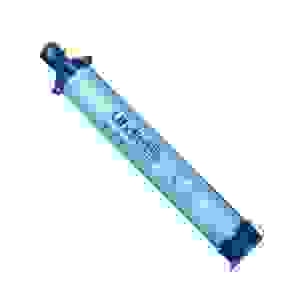
The Lifestraw is a hollow-membrane filter built into a straw. You place the straw into the water, and drink. Sucking the water up through the straw forces it through the filter, which removes 99.9999% of bacteria, and 99.9% of protozoa, down to 0.2 microns, with a filter that lasts for 1000 liters, for about $20. Not bad, right?
That’s pretty good, but on the downside, it won’t remove microscopic minerals, chemicals, or viruses.
This isn’t necessarily a deal-breaker, since most water will be fine, especially if you’re just filtering river water to avoid getting sick…but this thing was designed for the third world, with viruses all over the place, meaning you’d need iodine or other methods to eliminate the potential threat of viral diseases.
It’s certainly better than nothing, and preventing most water-borne diseases is better than preventing none. The Lifestraw was designed to provide excellent filtration at a reasonable cost, which is probably more effective than providing perfect filtration at a high cost, which could very well be too expensive to accomplish its own goals of third world disease reduction. Again, missing the viruses isn’t a deal-breaker, and it can prevent a huge number of water-borne diseases from infecting at-risk populations, but people talk about this thing like it’s the messiah of water filters.
But that’s not even the most annoying part.
The weird problem no Lifestraw review ever seems to mention
I have gone over this problem again and again in my head, looking at the endless cavalcade of glowing Lifestraw reviews, “Invention of the Century” accolades, and legions of ardent fans, and cannot fathom why no one seems to notice or care.
Take a look at the snazzy in-action shot of a guy using the Lifestraw out in the real world:
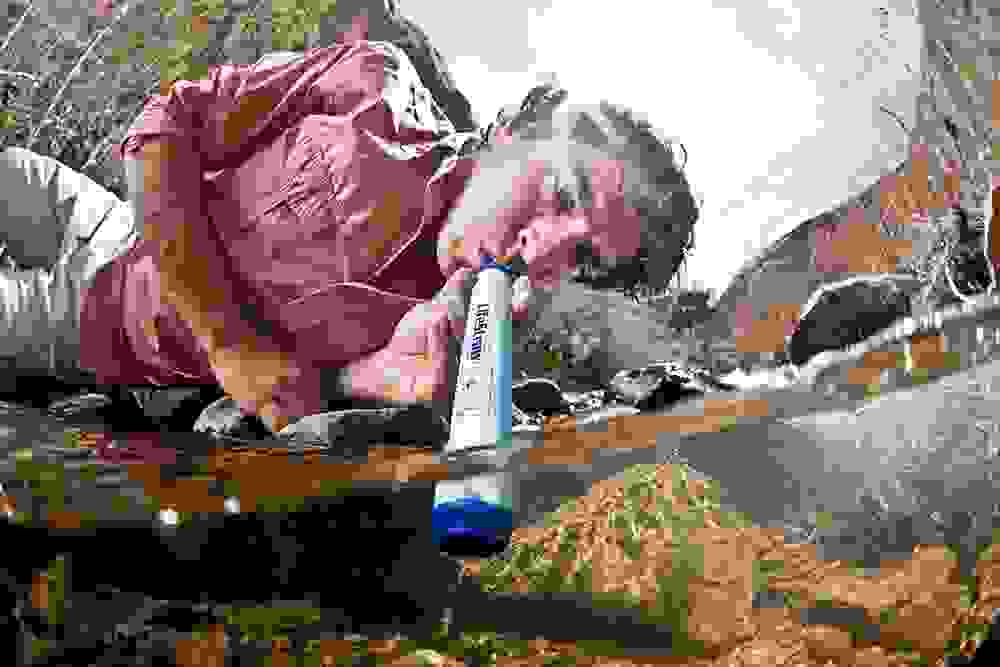
What happens when you walk away from the water?
No more water.
So if you’re heading into riverless mountains, or the desert, or a 12 hour bus ride in body-temperature heat, or any other situation in which you won’t have access to water, you’ll have to fill up a water bottle ahead of time, and whenever you want a drink of water, you have to:
- Open the bottle
- Open the Lifestraw’s top cap
- Open the Lifestraw’s bottom cap
- Stick the Lifestraw inside
- Drink
- Take it out
- Expel the remaining water
- Close the top cap
- Close the bottom cap
- Close the bottle.
And then…you’ve got a wet Lifestraw, so you’ll probably end up with wet clothes. Sexy!
People talk about how “simple” this is, as if handling three caps instead of one is somehow…simple?
On a related note, imagine traveling with this thing, and trying to fill up from a sink. You’d have to plug the sink, fill it up, wait for it to get deep enough to drink, then take a few sips, unplug the sink, and walk away. Imagine being incredibly thirsty and trying to do this in a hurry. Now imagine you’re about to get on a 12 hour bus ride through midday temperature highs, and all you had ahead of time was a quick sip from the sink, and that’s all you’ll have until the next time you get to another sink, when you’d begin the sink plug process anew. Just for one sip.
Seriously, has anyone actually used this thing?
What the Lifestraw should have been
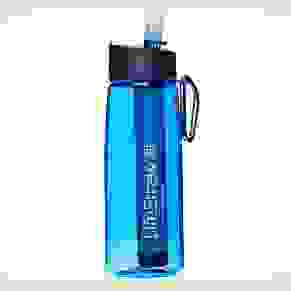
So here we finally are, at a product that’s actually recommendable. The Lifestraw Go. They took the Lifestraw and stuck it inside a water bottle, which eliminates the pointless inconvenience of only being able to drink with water nearby, or having to deal with three different caps and two separate objects for every sip.
But damn…the Lifestraw has been around since about 2005, and this bottled version only started shipping around 2013. This means that for 8 long years, nobody ever bothered asking “Dude, what if you walk away from the river but you’re still thirsty?” Sigh.
This bottled version was designed for the consumer market, which makes a lot of sense, and it’s true that shipping a million regular Lifestraws to disaster zones or poverty-stricken rural areas is logistically easier than shipping a million bottled Lifestraws, as they’d need maybe 5 or 6 times as many shipments due to the size, but damn…how does anyone use the regular one more than a few times without going crazy?
While it’s true that the original Lifestraw was designed for simplicity, portability, durability, and ease of use (and somewhat succeeds), I just can’t see many good reasons not to stick it inside a water bottle in the first place. Particularly from a consumer standpoint, the bottled version is clearly the correct answer here.
Update: I can think of ONE situation in which the straw by itself might be more useful than a bottle: Trail running, near a river. You can strap it to your leg, so it doesn’t bounce around, and you’re always near an outdoor water source, which would only need this type of filtration, and wouldn’t need a bottle.
But, ranting aside, is it a good filter? Is it a cost-effective solution to commonplace water purification needs, third world or otherwise? Could this be the one and only water purification method you employ, whether hiking in the mountains, or adventuring throughout the developing world?
Well…maybe.
Remember, it still can’t filter viruses, which is what you’d want in developing countries.
That’s not to say it’s not useful. A $35 water bottle that provides 0.2 micron filtration which lasts for 1000 liters certainly isn’t bad.
But on the other hand, you can just get the Sawyer Water Bottle, which manages 0.1 micron filtration for a guaranteed 3.7 million liters for a one-time cost of $50.
Um…tell me again, why is the Lifestraw so popular?
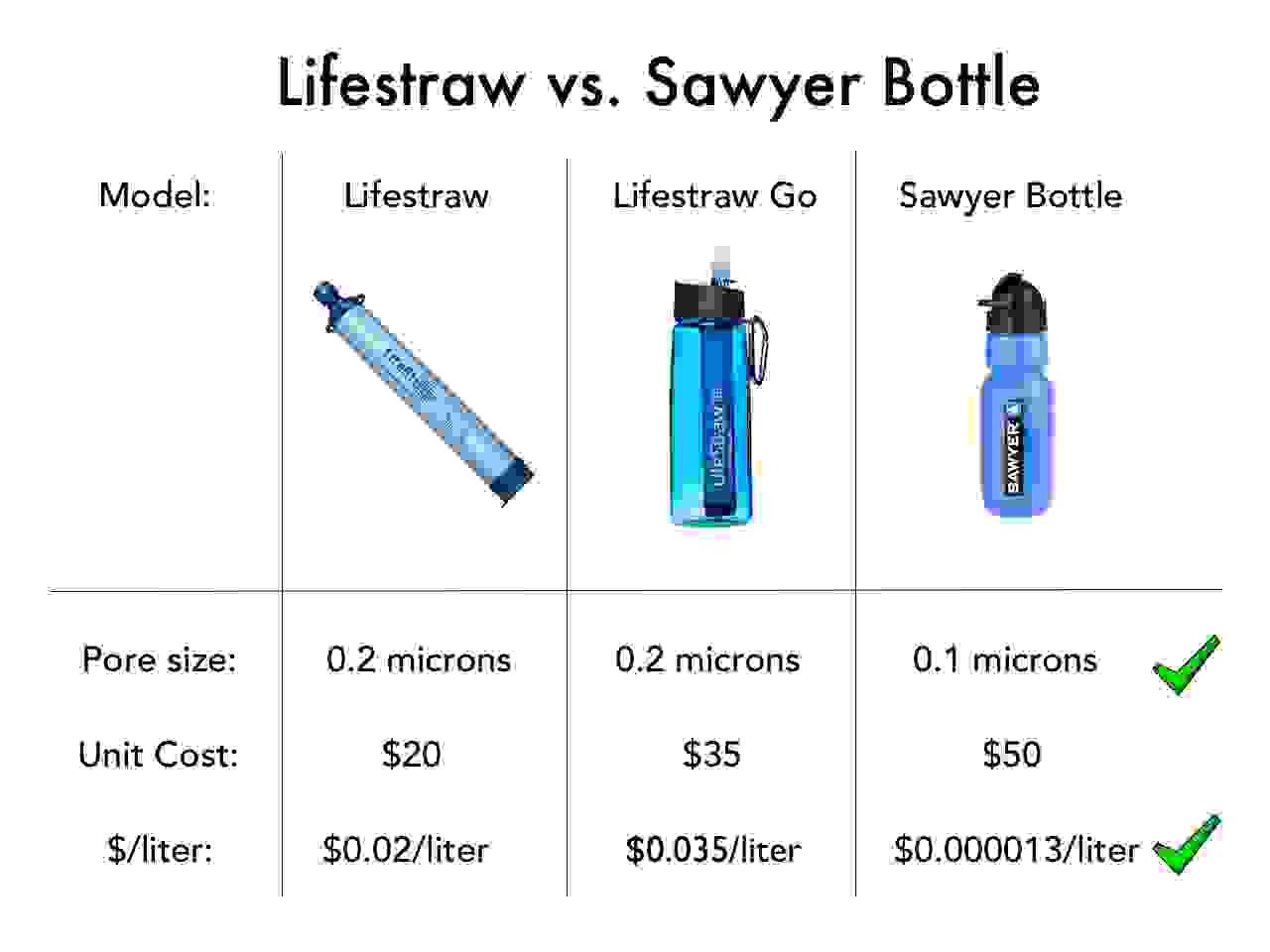
It has been claimed that the Lifestraw’s lifespan estimates are intended to be a little on the safe side, using low-quality water for all of its tests, which is good (and Sawyer’s lofty claims were put to the test, and were sadly shown to come up short, so the performance difference is likely to be smaller than what is claimed). And again, it’s not that it’s bad, and the filtration quality will probably work just fine if you’re hiking in North America, and you could supplement it with iodine tablets if you ever take it with you to Mexico, or wherever else you might want anti-viral protection. And if you’re drinking a liter of water per day, a $35 Lifestraw Go will last almost 3 years, which isn’t bad at all, and if you’re only using it for camping trips on weekends, it’ll last much longer. I also think it looks nicer than the Sawyer. So it’s definitely good; it’s just not necessarily the best, neither on filtration quality, nor on cost-effectiveness.
Update: After receiving and using the Lifestraw Go, I can say that it’s a pretty good product for hikers who plan on filling up from a river and just want a simple water bottle filter to do the job. Its filtration performance isn’t as strong as the Sawyer, nor is it as cost-effective, but it’s still effective and affordable, for non-viral filtration. Keep in mind it’s supposed to filter biological contaminants rather than chemical, meaning it’s more suited to filtering clear river water than tap water, which is more likely to have chemicals of some sort.
Two issues: Firstly, the Lifestraw Go does not use the regular Lifestraw as a replacement filter, but instead uses a slightly modified version. This means you cannot replace the filter inside the Lifestraw Go with a regular Lifestraw, and, at the moment anyway, you cannot buy just the replacement filter by itself. When your Lifestraw Go reaches the end of its life, you’ll have to buy an entirely new bottle. I expect that if the product is successful that they will offer those replacement filters by themselves, but it’s worth being aware of this issue.
Secondly, when the bottle is shut and the straw is folded down, it protrudes slightly beyond the edge of the lid, and it’s easy to get your grubby hands all over the straw when you pick up the bottle, potentially getting the straw a little dirty and thus defeating the purpose of drinking filtered water. This could be easily fixed, and I hope they do it. Second update: THEY DID!
If you think it’s for you, check it out here.
But again, neither of these devices will provide chemical or viral filtration. If you want to get rid of viruses, then you’ll need iodine tablets, or a UV light, or upgrade to a water bottle that actually gets rid of viruses, too.
What if I need serious purification?
For most people, high-quality filtration works just fine. If you’re hiking in North America or filtering tap water while traveling through modern countries, you probably don’t need virus removal to be safe. But if you’re traveling in developing countries with incredibly questionable tap water, you might want to take some extra precautions.
And yes, you can fit a whole purifier right inside a water bottle, like these do:
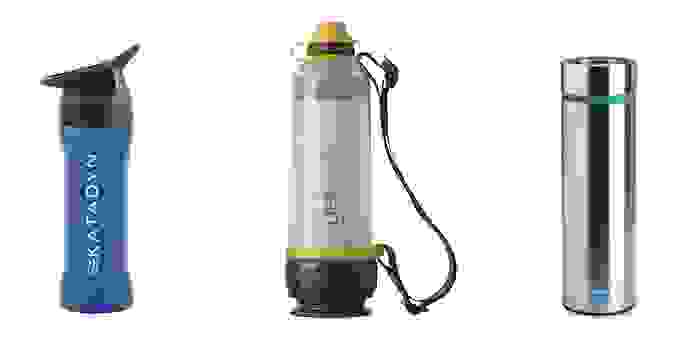
Each of these will clean out viruses, along with all the other contaminants, including chemical, that you’d want removed, providing thorough filtration beyond anything the Lifestraw can manage. Check out a thorough review of those three, including short and long term cost estimates, and suggested uses for each. They all work differently, without any objectively “best” option, so you’ll want to find a favorite that works for you. I’m currently using the GRAYL, which manages the nice trick of allowing multiple options for filtration quality as needed, and also looks nice and classy.
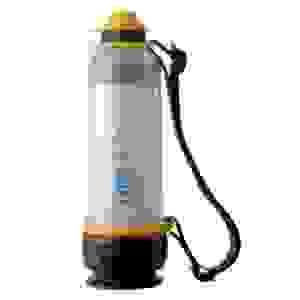
But I’d also like to highlight a close competitor to the Lifestraw, one which shares the design goal of providing high-quality, portable, durable water filtration to vulnerable populations in the third world, and which demonstrates what the Lifestraw could have been. It’s the Lifesaver Bottle, and it’s 13 times better.
The pores in the Lifestraw are 0.2 microns, whereas the pores in the Lifesaver are 0.015 microns, making them about 1/13th the size, which is small enough that viruses can’t get in. No more worrying about having to use iodine tablets.
It’s true that the Lifesaver is bigger, heavier, bulkier, and significantly more expensive (though long-term costs are actually quite good), whereas the Lifestraw was supposed to be so tiny and portable that you can take it with you wherever you go, which might actually mean it gets used more frequently by those who don’t want to bring along a bottle all the time. But…if you need a bottle anyway, and you want portable virus filtration, the Lifesaver wins.
Yet nobody seems to know it exists.
So why does everyone love the Lifestraw?!?!
Well, I don’t really know. It was even called the “Invention of the Century,” from a publication I otherwise enjoy, despite lower performance and higher long-term cost than competing options that have been on the market for years.
Again, it’s not bad, and the bottled version solves quite a bit of the silly ridiculousness of the straw-only version, but everyone adores the straw-only version, as a consumer product, which is absolutely inexplicable to me.
But I have a theory:
At $20, it’s cheaper than many other filters, and, admittedly, its filtration capability is pretty good, and a lot better than most of what I’ve seen for the same initial cost. It has a nice impulse-buy price point that gets people interested, and its unique design sets it apart in a world of filtered pitchers, faucet adapters, and so on. And when it arrives in the mail, people give it a try, drinking from a cloudy glass of water, and impressing some friends. Buyers are left happy.
And then they never use it.
Seriously. If you read the Lifestraw reviews on Amazon, you’ll see lots and lots of people talking about how great it is, who stuffed it into an emergency preparedness kit and never bothered with it again. They’re rating the product on how cool they think it is, not how practical it is in real-world use.
People actually love it so much that they videotape themselves drinking from jars of water full of feces…which is explicitly something the Lifestraw cannot handle, because water contaminated this way can easily have viruses inside, which the Lifestraw is incapable of removing. There’s a level of enthusiasm for this product that is literally dangerous.
So is the Lifestraw useful at all?
I would like to clarify that I am examining the Lifestraw from a consumer standpoint, rather than from a disaster-relief or third world disease alleviation product. It offers plenty of functionality in those situations, especially the Lifestraw Family, which is a larger (though still portable) filter intended for home use that does remove viruses. Most of my annoyance should be directed toward the overrating fanboys, who post videos of people drinking toilet water, and then resort to third-grade name-calling if anyone ever criticizes its performance or design.
So it’s certainly not horrible, particularly the bottled version, which is the only one you should bother looking at. Its filtration capability is actually quite good, and it’s pretty convenient. I just think it has been played up way too much in the media, and people salivate over it like it’s this work of art that no disaster-preparedness kit should ever be without.
Just remember that it is incapable of handling chemical and viral contamination, meaning you should only use it within a narrow band of circumstances; outdoor recreation, in North America (and similar settings), where the water you come across has neither chemicals nor viruses.
So it’s certainly worth a look, but I can’t say it’s the best. Competing products provide better filtration at a more cost-effective price, while other devices handle viruses as well, which is what you’d want in developing countries.
Check it out, but remember to…filter some of the adoration.




Hey Nomad I listened to your negative rant about the amazing LIFESTRAW concept. I think you were over NEGATIVE about a great product. Sure there is always something better coming along. You mentioned “Virus’s” as one of the big problems with this filter; you know as well as I do; #1 that 99% of the water in the US is virus free and #2 that most portable water filters on the market do not filter down to .1 Microns anyway. Your other concern was putting a wet filter back into your pocket, how would you not get the outside of any of the other filters wet and not have the same problem, whether it were a straw or bottle you had to dip in the river to fill it, now it’s wet? You also did not like to lie down to drink. Let’s face it, if you have to use this LIFESTRAW on a regular basis something must be going on in the world and laying low at the water hole is a smart idea. You could trash any water filter by stating what it did not do, like not filtering fluoride or radiation and other Nuclear Contaminants. You also seem to be overly concerned about this filter being used in third world countries where there “are viruses” in the water. I would just say, if the people in those countries were able to survive Bill Gates vaccines then they are not worried about viruses. . For your own info your review sounded bias not informative. The LIFESTRAW is a great concept, very light weight and affordable. I keep one in my car and backpack as well as other filters because it is affordable to have more then one.
So the reason a regular water bottle wouldn’t have the problem of getting your clothes wet is that you only have to fill it up once, and then drink from it until it’s empty, whereas with the Lifestraw you have to do that with every sip. Also, bottles are stored in backpack pockets, where they’re away from you. I meant the wet clothes thing as kind of a joke, but it’s still a nuisance that a water bottle would solve. Also, if you’re supposed to carry it around your neck, you’re getting contaminated water all over your clothes all day. Again: Not a deal breaker. But a pointless, solvable problem that doesn’t need to happen. Same is true for the rest of the points. Virus filtration and not having to lie down could both be solved with better technology inside a water bottle. I stand by my hypothesis that Lifestraw fans just aren’t using it very much, or don’t have a water filtration bottle to compare, because if they had both side by side, they’d grab the bottle every time.
Life straw, bring an empty nalgene, fill up with water, use it in the nalgene. Problem solved with having to lay on your belly.
True, but I still don’t see the point of this as opposed to just getting the bottled version instead. It’s just an instant sip instead of having to juggle two items at the same time.
Appreciated your Lifestraw vs. other water filters review. I had no idea there was so much to think about in this regard. You were most informative and, I felt, thorough in comparisons–which is fair. A tremendous help to me. (Want to be wisely prepared for the big earthquake, and no doubt subsequent flooding, due our state.) Please sign me up for your newsletter, and keep up the excellent work.
Thank you.
Salt Lake City, UT
Thanks! Happy to help. It’s weird how people have gotten so upset with this article, despite some relatively simple facts, which are important in specific cases…but oh well.
The newsletter signup is over on this page, where there’s a choice between monthly roundups or as-soon-as-they’re-published updates.
I read your entire review, then read it again to make certain I had understood everything. While I do agree that you make some valid points about some of the shortcomings of the LifeStraw, you did a lot of nit-picking over things that in the end are not that big of a deal. I have used the LifeStraw for 4-5 years, and I have never been negatively effected by any of the water it filtered. But the most ridiculous thing said in your review was making a big deal about removing the end caps on the LifeStraw. Come on, is that something anyone would care about if they needed water? I think not.
You keep talking about the greatness that is iodine, but some of us are deadly allergic to that stuff! If I so much as look at an iodine tablet, my throat swells up and I suffocate. I’d rather take my chances with the viruses! :(
For viral filtration, check out the options on this list. Several of them clean out viruses without using iodine.
Thank you! Can’t wait to read what you have to say about virus filtration. I have an autoimmune disease, including thyroid disease, and cannot take iodine. I also travel in countries where I worry about viruses. My first concern about the LifeStraw was whether it could filter out viruses. Thank you for taking this issue seriously. For someone like me, yes, it could be a matter of life or death — or of not being able to travel.
(From the comments below, it looks like the LifeSaver bottle is no longer available. Can you please post an update on this? I just bought a Grayl ultralight, but am not sure if it is the product that would best meet my needs).
Hmm, I’m still seeing Lifestraws available in bottles. Just look up “Lifestraw” on REI or something like that. But they can’t handle viruses, and very few filters can, except for the pump filters, which get kind of annoying. The Grayl can handle them just fine.
The one problem no one mentions with LS is not what you’re saying. The issues you have are due to you not being willing to change certain behaviors or routines, not due to actual issues with the product itself.
The actual problem with the LS is that it NEVER dries out and ends up contaminated with bacteria. I live in a place that’s 95 degrees in summer with 15% humidity and my LS can take up to a week or more to dry out, and of course that’s with the caps open. I used mine four days ago, purged it until not one drop would come out both by blowing into it and the pinwheeled my arm to fling any remaining water out. Then I let it hang near a heater for two days and it was still holding water. Yesterday I set it directly in the path of a running dehumidifier, and this morning there was still a few tablespoons of water somehow inside, I actually had to purge it again!
I wish someone would address this issue because the bacterial growth not only makes the LS a risk even after only one use, but also bacterial colonies can get large enough to prematurely clog it. My first LS became mostly clogged far before the quoted limit and I don’t use muddy water, only settled or mostly clear water.
The Lifesaver Bottle has been recalled and Lifesaver Systems is asking all customers to discontinue use of the bottles. Read about it here: http://www.lifesaversystems.com/documents/LIFESAVER_Warning.pdf
Dang. Thanks for the warning. I hope they get it fixed. Looks like it’s a flaw in one specific production run, but they’re still testing the others. I hope it works out.
An update in the article would be appreciated… For clarity’s sake and until further notice.
In that link it says other versions of the bottle have achieved the correct performance, so it’s not quite a problem with the product itself; however, the company seems to be up for sale, and you can’t buy from them anyway. I hope I don’t have to update it with a “this amazing thing doesn’t exist anymore” type of comment…
Please note the warning issued by Lifesaver on October 28, 2015: http://www.lifesaversystems.com/documents/LIFESAVER_Warning.pdf
Thanks Mate! Great read! I will be looking into these filter systems for my bugout bags!
Thanks for the article. I’d agree some of your points are a little blown out but again thanks for the info, as I wouldn’t have thought about viruses and it’s good to know as long as I’m in NA the lifestraw should have me covered. I bought a lifestraw because it was the cheapest solution. I did also notice most of the reviews on amazon were from one time toilet and or dishwater “test” uses.
I brought two 32 oz Gatorade bottles, a cheap crap Walmart plastic bag sort of canteen thing and the lifestraw and did just fine for two days in the mountains. The Walmart canteen fit in the bottom of the lifestraw. Filled the canteen with water, held pressure against it and squeezed it until water flowed through the lifestraw into the Gatorade bottle. The only major dysfunction was if you don’t tilt it right or hold the two things tight enough together the unfiltered water can run down the straw into the Gatorade bottle.
Here is my experience that may be of interest to anyone that may depend on the portable “straw” . After using in for one DAY with water that was not contaminated with any visible sediment it ceased to function, blocked completely. After drying for a few days it remains blocked.
On return to the US I called the only number I could find for Earth Easy and got zero help, the customre service rep had no idea why it had failed or what to do about it. I explained that I was not concerned with getting a new unit however it was critical to determine why it failed in the first place. She was unable to answer this and unconcerened about getting the unit for testing.
There may be a known defective batch? This was manufactured Feb 2014.
I have no idea why this failed but won’t be taking Life Straw anything on the next trip. There are better options and highly reliable options out there.
Anyone one have similiar experience.